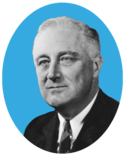| This article needs additional citations for verification. Please help improve this article by adding citations to reliable sources. Unsourced material may be challenged and removed. Find sources: "1936 Democratic National Convention" – news · newspapers · books · scholar · JSTOR (May 2014) (Learn how and when to remove this message) |
| 1936 presidential election | |
  Nominees Nominees Roosevelt and Garner | |
| Convention | |
|---|---|
| Date(s) | June 23–27, 1936 |
| City | Philadelphia, Pennsylvania |
| Venue | Convention Hall Franklin Field |
| Candidates | |
| Presidential nominee | Franklin D. Roosevelt of New York |
| Vice-presidential nominee | John N. Garner of Texas |
| ‹ 1932 · 1940 › | |
The 1936 Democratic National Convention was held in Philadelphia, Pennsylvania from June 23 to 27, 1936. The convention resulted in the nomination of President Franklin D. Roosevelt and Vice President John N. Garner for reelection.
Changes to rules
At the 1936 Democratic Convention, the rule requiring candidates for president and vice president to have a majority of two-thirds of the delegates votes to win nomination, which had existed since 1832, was abolished.
Roosevelt had long pushed for the rule's abolition, in part due to past deadlocks: for example, the 1924 convention had required 103 ballots over roughly two weeks to nominate John W. Davis.
The conventioneers provided that a simple majority of delegates would be required to win nomination, allowing for candidates to more easily be nominated and thus produce less balloting. In this regard, only one Democratic Convention after 1932 has required multiple ballots (that of 1952, which required three).
This also began the decline of the South's clout at Democratic conventions, making it easier for the Democrats to begin adopting civil rights and other liberal ideas into their platforms, since the two-thirds rule had long given the South a de facto veto power on presidential nominees.
With the rule's abolition, Missouri Senator Bennett Champ Clark noted that "the Democratic Party is no longer a sectional party, it has become a great national party." Southern Democrats would continue to decline in power, ultimately leading to the Dixiecrat movement and Nixon's 1968 Southern strategy.
South Carolina Senator Ellison D. Smith walked out of the convention once he saw that a black minister, Marshall L. Shepard, was going to deliver the invocation.
Results
The Balloting:
| Democratic National Convention presidential vote, 1936 | |
|---|---|
| Candidates | 
|
| Name | Franklin D. Roosevelt |
| Certified Votes | Voice Vote(100.00%) |
| Margin | 0 (0.00%) |
President Roosevelt and Vice President Garner were renominated by acclamation without need for a roll-call vote.
In his acceptance speech on June 27 at the adjacent Franklin Field, Roosevelt remarked, "This generation of Americans has a rendezvous with destiny."
See also
- History of the United States Democratic Party
- 1936 Democratic Party presidential primaries
- List of Democratic National Conventions
- United States presidential nominating convention
- 1936 Republican National Convention
- 1936 United States presidential election
References
- ^ Schulman, Bruce (1994). From Cotton Belt to Sunbelt: Federal Policy, Economic Development, and the Transformation of the South, 1938-1980. Duke University Press. pp. 44–46. ISBN 0822315378. Retrieved October 8, 2015.
- "Curtains for Cotton Ed". Time. August 7, 1944. Archived from the original on October 23, 2012. Retrieved May 9, 2012.
External links
- Democratic Party Platform of 1936 at The American Presidency Project
- Roosevelt Nomination Acceptance Speech for President at DNC (transcript) at The American Presidency Project
- A film clip "Democrats Cheer, 1936/06/24 (1936) is available for viewing at the Internet Archive
| Preceded by 1932 Chicago, Illinois |
Democratic National Conventions | Succeeded by 1940 Chicago, Illinois |
| (← 1932) 1936 United States presidential election (→ 1940) | |||||||||||||||
|---|---|---|---|---|---|---|---|---|---|---|---|---|---|---|---|
| Democratic Party |
| ||||||||||||||
| Republican Party |
| ||||||||||||||
| |||||||||||||||
| (1935←) 1936 United States elections (→1937) | |
|---|---|
| President | |
| U.S. Senate |
|
| U.S. House |
|
| State governors |
|
| State legislatures | |
| Franklin D. Roosevelt | |
|---|---|
| |
| Presidency (timeline) |
|
| Presidential foreign policy |
|
| Presidential speeches |
|
| Other events | |
| Elections | |
| Life and homes | |
| Legacy |
|
| Family (Roosevelt • Delano) |
|